Combined Multilevel Monitoring and Wavelet Transform Analysis Approach for the Inspection of Ground and Surface Water Dynamics in Shallow Coastal Aquifer
Abstract
:1. Introduction
2. Materials and Methods
2.1. Study Area
2.2. Monitoring System and Profiling
2.3. Wavelet Analysis
2.3.1. The Continuous Wavelet Transform (CWT)
2.3.2. Wavelet Coherence (WTC)
3. Results
3.1. Surface Water Dynamics
3.2. Groundwater Dynamics
3.3. Periodicity Features
3.4. Coherence Analysis
4. Discussion
5. Conclusions
- The transient regime of surface water in the Jasenska channel is significantly influenced by the operative regime of the PS Modric. This is especially seen in water level, while the water temperature is evidently driven by the solar radiation since the limited channel depth. EC in the Jasenska channel is shown to be under the simultaneous influence of the river Neretva surface layer and Mala Neretva water, which is introduced into the system via the Crepina channel;
- The Diga area is characterized by the active sea water intrusion influence, which is the main driving force in the definition of the Diga groundwater EC. Although the small distance and previously shown impact of the PS Modric to irrigation channels and consequently to average groundwater level, the influence of PS Modric to P1 groundwater EC fluctuations has been characterized as minor;
- Compared to the Diga area, the Jasenska area groundwater EC features imply an equilibrium of the Jasenska channel and sea water intrusion, thus creating significant stratification of the salinity regime as found in groundwater. Although the small distance from the Jasenska channel, the upper layer of the P2 groundwater does not seem suitable for irrigation use following FAO standards [52];
- The implemented monitoring system demonstrated a capacity to capture for the consequences of sea water intrusion, precipitation and PS Modric operative regime to both ground and surface water features within the area of interest. A similar system, when adapted to specific circumstances found at the site, can be applied to monitor the water ecosystem features in coastal systems of interest.
Author Contributions
Funding
Institutional Review Board Statement
Informed Consent Statement
Data Availability Statement
Acknowledgments
Conflicts of Interest
References
- Essink, G.H.P.O.; Van Baaren, E.S.; De Louw, P.G.B. Effects of climate change on coastal groundwater systems: A modeling study in The Netherlands. Water Resour. Res. 2010, 46. [Google Scholar] [CrossRef]
- Custodio, E. Coastal aquifers of Europe: An overview. Appl. Hydrogeol. 2009, 18, 269–280. [Google Scholar] [CrossRef]
- Werner, A.D.; Bakker, M.; Post, V.E.; Vandenbohede, A.; Lu, C.; Ataie-Ashtiani, B.; Simmons, C.T.; Barry, D. Seawater intrusion processes, investigation and management: Recent advances and future challenges. Adv. Water Resour. 2012, 51, 3–26. [Google Scholar] [CrossRef]
- Ketabchi, H.; Mahmoodzadeh, D.; Ataie-Ashtiani, B.; Simmons, C.T. Sea-level rise impacts on seawater intrusion in coastal aquifers: Review and integration. J. Hydrol. 2016, 535, 235–255. [Google Scholar] [CrossRef]
- Racetin, I.; Krtalic, A.; Srzic, V.; Zovko, M. Characterization of short-term salinity fluctuations in the Neretva River Delta situated in the southern Adriatic Croatia using Landsat-5 TM. Ecol. Indic. 2019, 110, 105924. [Google Scholar] [CrossRef]
- Mastrocicco, M.; Colombani, N. The Issue of Groundwater Salinization in Coastal Areas of the Mediterranean Region: A Review. Water 2021, 13, 90. [Google Scholar] [CrossRef]
- Paldor, A.; Shalev, E.; Katz, O.; Aharonov, E. Dynamics of saltwater intrusion and submarine groundwater discharge in confined coastal aquifers: A case study in northern Israel. Appl. Hydrogeol. 2019, 27, 1611–1625. [Google Scholar] [CrossRef]
- Vallejos, A.; Solá, F.; Pulido-Bosch, A. Processes Influencing Groundwater Level and the Freshwater-Saltwater Interface in a Coastal Aquifer. Water Resour. Manag. 2014, 29, 679–697. [Google Scholar] [CrossRef]
- Levanon, E.; Yechieli, Y.; Gvirtzman, H.; Shalev, E. Tide-induced fluctuations of salinity and groundwater level in unconfined aquifers—Field measurements and numerical model. J. Hydrol. 2017, 551, 665–675. [Google Scholar] [CrossRef]
- Yang, H.; Shimada, J.; Shibata, T.; Okumura, A.; Pinti, D. Freshwater lens oscillation induced by sea tides and variable rainfall at the uplifted atoll island of Minami-Daito, Japan. Appl. Hydrogeol. 2020, 28, 2105–2114. [Google Scholar] [CrossRef]
- Mancuso, M.; Carol, E.; Kruse, E.; Rodrigues, F.M. Coastal aquifer hydrodynamics and salinity in response to the tide: Case study in Lisbon, Portugal. Water Policy 2016, 48, 240–252. [Google Scholar] [CrossRef]
- Wood, C.; Harrington, G.A. Influence of Seasonal Variations in Sea Level on the Salinity Regime of a Coastal Groundwater-Fed Wetland. Groundwater 2014, 53, 90–98. [Google Scholar] [CrossRef]
- Zeng, X.; Wu, J.; Wang, D.; Zhu, X. Assessing the pollution risk of a groundwater source field at western Laizhou Bay under seawater intrusion. Environ. Res. 2016, 148, 586–594. [Google Scholar] [CrossRef]
- Levanon, E.; Yechieli, Y.; Shalev, E.; Friedman, V.; Gvirtzman, H. Reliable Monitoring of the Transition Zone Between Fresh and Saline Waters in Coastal Aquifers. Ground Water Monit. Remediat. 2013, 33, 101–110. [Google Scholar] [CrossRef]
- Kim, K.-Y.; Chon, C.-M.; Park, K.-H.; Park, Y.-S.; Woo, N.-C. Multi-depth monitoring of electrical conductivity and temperature of groundwater at a multilayered coastal aquifer: Jeju Island, Korea. Hydrol. Process. 2008, 22, 3724–3733. [Google Scholar] [CrossRef]
- Yang, H.; Kagabu, M.; Okumura, A.; Shimada, J.; Shibata, T.; Pinti, D.L. Hydrogeochemical processes and long-term effects of sea-level rise in an uplifted atoll island of Minami-Daito, Japan. J. Hydrol. Reg. Stud. 2020, 31, 100716. [Google Scholar] [CrossRef]
- Lovrinović, I.; Bergamasco, A.; Srzić, V.; Cavallina, C.; Holjević, D.; Donnici, S.; Erceg, J.; Zaggia, L.; Tosi, L. Groundwater Monitoring Systems to Understand Sea Water Intrusion Dynamics in the Mediterranean: The Neretva Valley and the Southern Venice Coastal Aquifers Case Studies. Water 2021, 13, 561. [Google Scholar] [CrossRef]
- Ratner-Narovlansky, Y.; Weinstein, Y.; Yechieli, Y. Tidal fluctuations in a multi-unit coastal aquifer. J. Hydrol. 2019, 580, 124222. [Google Scholar] [CrossRef]
- de Oliveira Gomes, O.V.; Marques, E.D.; Kütter, V.T.; Aires, J.R.; Travi, Y.; Silva-Filho, E.V. Origin of salinity and hydrogeochemical features of porous aquifers from northeastern Guanabara Bay, Rio de Janeiro, SE-Brazil. J. Hydrol. Reg. Stud. 2019, 22, 100601. [Google Scholar] [CrossRef]
- Sunkari, E.D.; Seidu, J.; Ewusi, A. Hydrogeochemical evolution and assessment of groundwater quality in the Togo and Dahomeyan aquifers, Greater Accra Region, Ghana. Environ. Res. 2022, 208, 112679. [Google Scholar] [CrossRef]
- Bakker, M. Analytic Solutions for Tidal Propagation in Multilayer Coastal Aquifers. Water Resour. Res. 2019, 55, 3452–3464. [Google Scholar] [CrossRef]
- Erskine, A.D. The Effect of Tidal Fluctuation on a Coastal Aquifer in the UK. Groundwater 1991, 29, 556–562. [Google Scholar] [CrossRef]
- Bear, J.; Cheng, A.H.-D.; Sorek, S.; Ouazar, D.; Herrera, I. Seawater Intrusion in Coastal Aquifers: Concepts, Methods and Practices; Springer: Dordrecht, The Netherlands, 1999; ISBN 978-0-7923-5573-1. [Google Scholar]
- Guarracino, L.; Carrera, J.; Vázquez-Suñé, E. Analytical study of hydraulic and mechanical effects on tide-induced head fluctuation in a coastal aquifer system that extends under the sea. J. Hydrol. 2012, 450-451, 150–158. [Google Scholar] [CrossRef]
- Xia, Y.; Li, H.; Boufadel, M.C.; Guo, Q.; Li, G. Tidal wave propagation in a coastal aquifer: Effects of leakages through its submarine outlet-capping and offshore roof. J. Hydrol. 2007, 337, 249–257. [Google Scholar] [CrossRef]
- Abarca, E.; Karam, H.; Hemond, H.F.; Harvey, C.F. Transient groundwater dynamics in a coastal aquifer: The effects of tides, the lunar cycle, and the beach profile. Water Resour. Res. 2013, 49, 2473–2488. [Google Scholar] [CrossRef]
- Shalem, Y.; Weinstein, Y.; Levi, E.; Herut, B.; Goldman, M.; Yechieli, Y. The extent of aquifer salinization next to an estuarine river: An example from the eastern Mediterranean. Appl. Hydrogeol. 2014, 23, 69–79. [Google Scholar] [CrossRef]
- Kim, K.-Y.; Seong, H.; Kim, T.; Park, K.-H.; Woo, N.; Park, Y.-S.; Koh, G.-W.; Park, W.-B. Tidal effects on variations of fresh–saltwater interface and groundwater flow in a multilayered coastal aquifer on a volcanic island (Jeju Island, Korea). J. Hydrol. 2006, 330, 525–542. [Google Scholar] [CrossRef]
- Fadili, A.; Malaurent, P.; Najib, S.; Mehdi, K.; Riss, J.; Makan, A. Groundwater hydrodynamics and salinity response to oceanic tide in coastal aquifers: Case study of Sahel Doukkala, Morocco. Appl. Hydrogeol. 2018, 26, 2459–2473. [Google Scholar] [CrossRef]
- Heiss, J.W.; Michael, H.A. Saltwater-freshwater mixing dynamics in a sandy beach aquifer over tidal, spring-neap, and seasonal cycles. Water Resour. Res. 2014, 50, 6747–6766. [Google Scholar] [CrossRef]
- Kim, K.-Y.; Park, Y.-S.; Kim, G.-P.; Park, K.-H. Dynamic freshwater–saline water interaction in the coastal zone of Jeju Island, South Korea. Appl. Hydrogeol. 2008, 17, 617–629. [Google Scholar] [CrossRef]
- Zhang, X.; Dong, F.; Dai, H.; Hu, B.X.; Qin, G.; Li, D.; Lv, X.; Dai, Z.; Soltanian, M.R. Influence of lunar semidiurnal tides on groundwater dynamics in estuarine aquifers. Appl. Hydrogeol. 2020, 28, 1419–1429. [Google Scholar] [CrossRef]
- Srzić, V.; Lovrinović, I.; Racetin, I.; Pletikosić, F. Hydrogeological Characterization of Coastal Aquifer on the Basis of Observed Sea Level and Groundwater Level Fluctuations: Neretva Valley Aquifer, Croatia. Water 2020, 12, 348. [Google Scholar] [CrossRef] [Green Version]
- Krvavica, N.; Ružić, I. Assessment of sea-level rise impacts on salt-wedge intrusion in idealized and Neretva River Estuary. Estuarine, Coast. Shelf Sci. 2020, 234, 106638. [Google Scholar] [CrossRef] [Green Version]
- ESRI. ArcMap 10.8; Environmental Systems Research Institute: Redlands, CA, USA, 2021. [Google Scholar]
- Faculty of Civil Engineering; Geodesy and Architecture; University of Split. Salinity Monitoring at Lower Neretva Area—Report for The Year 2021; University of Split: Split, Croatia, 2021. [Google Scholar]
- Badaruddin, S.; Werner, A.D.; Morgan, L.K. Water table salinization due to seawater intrusion. Water Resour. Res. 2015, 51, 8397–8408. [Google Scholar] [CrossRef]
- Badaruddin, S.; Werner, A.D.; Morgan, L.K. Characteristics of active seawater intrusion. J. Hydrol. 2017, 551, 632–647. [Google Scholar] [CrossRef] [Green Version]
- Rahi, K.A.; Halihan, T. Identifying Aquifer Type in Fractured Rock Aquifers using Harmonic Analysis. Ground Water 2012, 51, 76–82. [Google Scholar] [CrossRef]
- Briciu, A.-E. Changes in Physical Properties of Inland Streamwaters Induced by Earth and Atmospheric Tides. Water 2019, 11, 2533. [Google Scholar] [CrossRef] [Green Version]
- Cheng, V.Y.; Saber, A.; Arnillas, C.A.; Javed, A.; Richards, A.; Arhonditsis, G.B. Effects of hydrological forcing on short- and long-term water level fluctuations in Lake Huron-Michigan: A continuous wavelet analysis. J. Hydrol. 2021, 603, 127164. [Google Scholar] [CrossRef]
- Grinsted, A.; Moore, J.C.; Jevrejeva, S. Application of the cross wavelet transform and wavelet coherence to geophysical time series. Nonlinear Process. Geophys. 2004, 11, 561–566. [Google Scholar] [CrossRef]
- Liu, Y.; Liang, X.S.; Weisberg, R.H. Rectification of the Bias in the Wavelet Power Spectrum. J. Atmos. Ocean. Technol. 2007, 24, 2093–2102. [Google Scholar] [CrossRef]
- Ng, E.K.W.; Chan, J.C.L. Geophysical Applications of Partial Wavelet Coherence and Multiple Wavelet Coherence. J. Atmos. Ocean. Technol. 2012, 29, 1845–1853. [Google Scholar] [CrossRef]
- Torrence, C.; Compo, G.P. A Practical Guide to Wavelet Analysis. Bull. Am. Meteorol. Soc. 1998, 79, 61–78. [Google Scholar] [CrossRef] [Green Version]
- Allen, M.R.; Smith, L.A. Monte Carlo SSA: Detecting irregular oscillations in the Presence of Colored Noise. J. Clim. 1996, 9, 3373–3404. [Google Scholar] [CrossRef]
- Levanon, E.; Shalev, E.; Yechieli, Y.; Gvirtzman, H. Fluctuations of fresh-saline water interface and of water table induced by sea tides in unconfined aquifers. Adv. Water Resour. 2016, 96, 34–42. [Google Scholar] [CrossRef]
- Werner, A. On the classification of seawater intrusion. J. Hydrol. 2017, 551, 619–631. [Google Scholar] [CrossRef]
- McIlvride, W.; Rector, B. Comparison of Short- and Long-Screen Monitoring Wells in Alluvial Sediments. In Proceedings of the Second National Outdoor Action Conference on Aquifer Restoration; Ground Water Monitoring and Geophysical Methods, Las Vegas, NV, USA, 23–26 May 1988; pp. 375–390. [Google Scholar]
- GEOKON Zagreb PLC. Drilling Report of Two Pairs of Piezometers Downstream of the Neretva River; GEOKON Zagreb PLC: Zagreb, Croatia, 2005. [Google Scholar]
- GEOKON Zagreb PLC. Geotechnical Investigation Works for Irrigation System Conceptual Design Downstream of the Neretva River; GEOKON Zagreb PLC: Zagreb, Croatia, 2008. [Google Scholar]
- Ayers, R.S.; Westcot, D.W. “Water Quality for Agriculture”, FAO Irrigation and Drainage Paper No. 29; FAO: Rome, Italy, 1994. [Google Scholar]
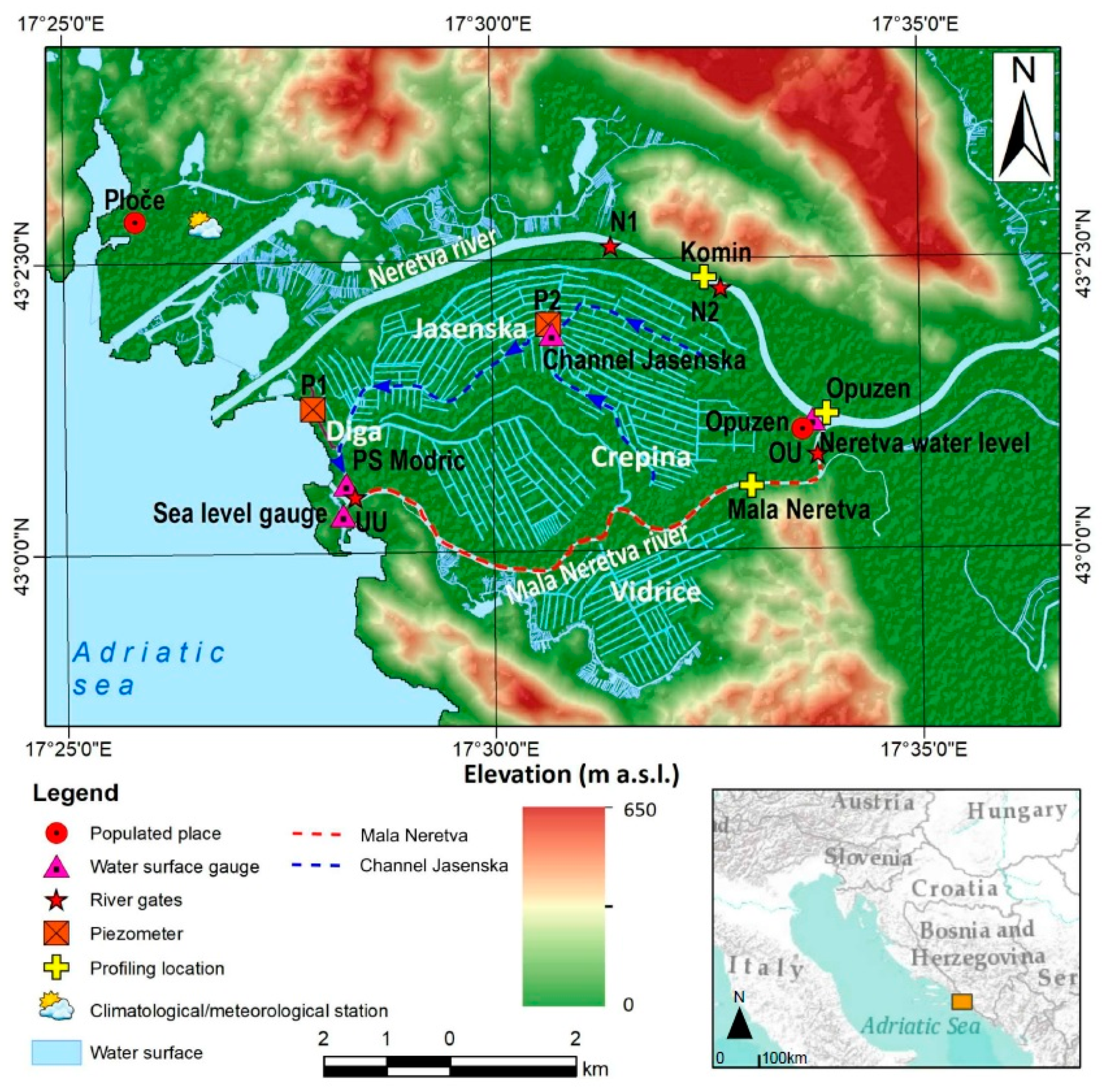


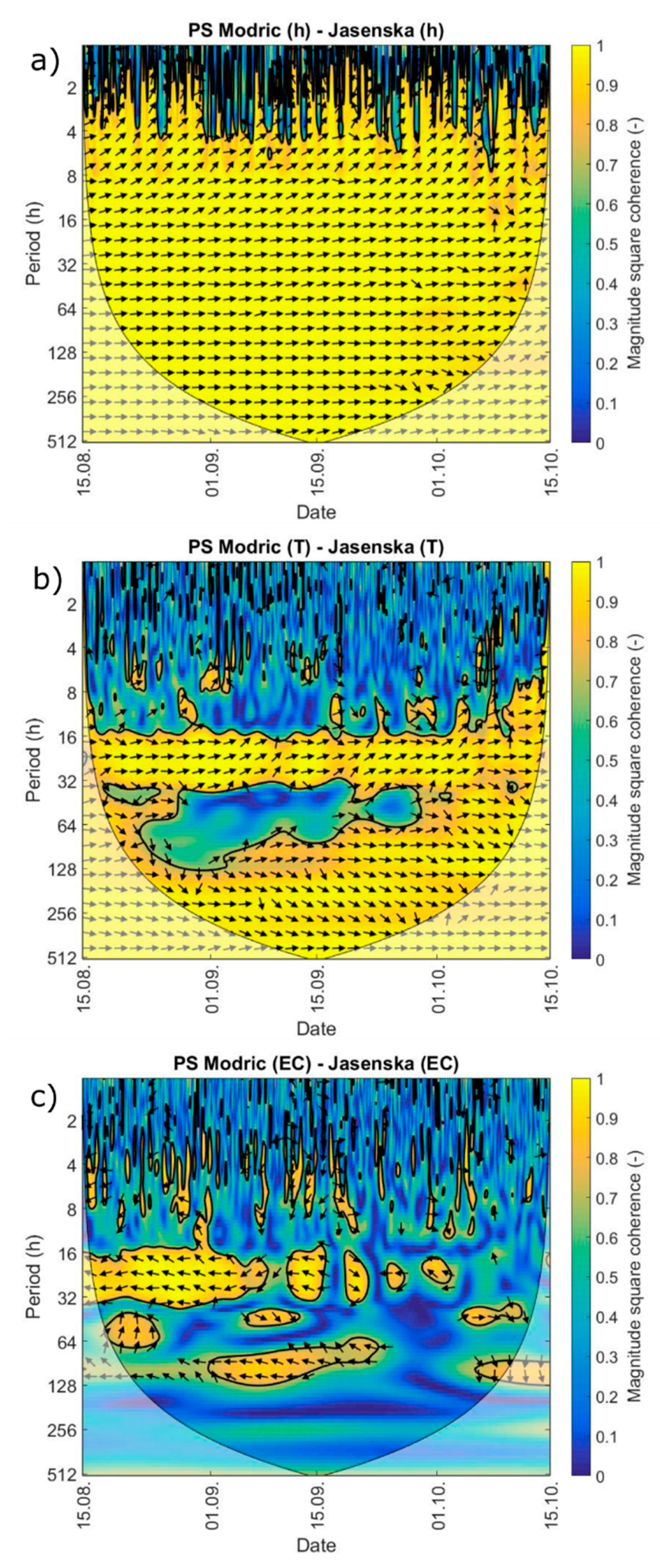
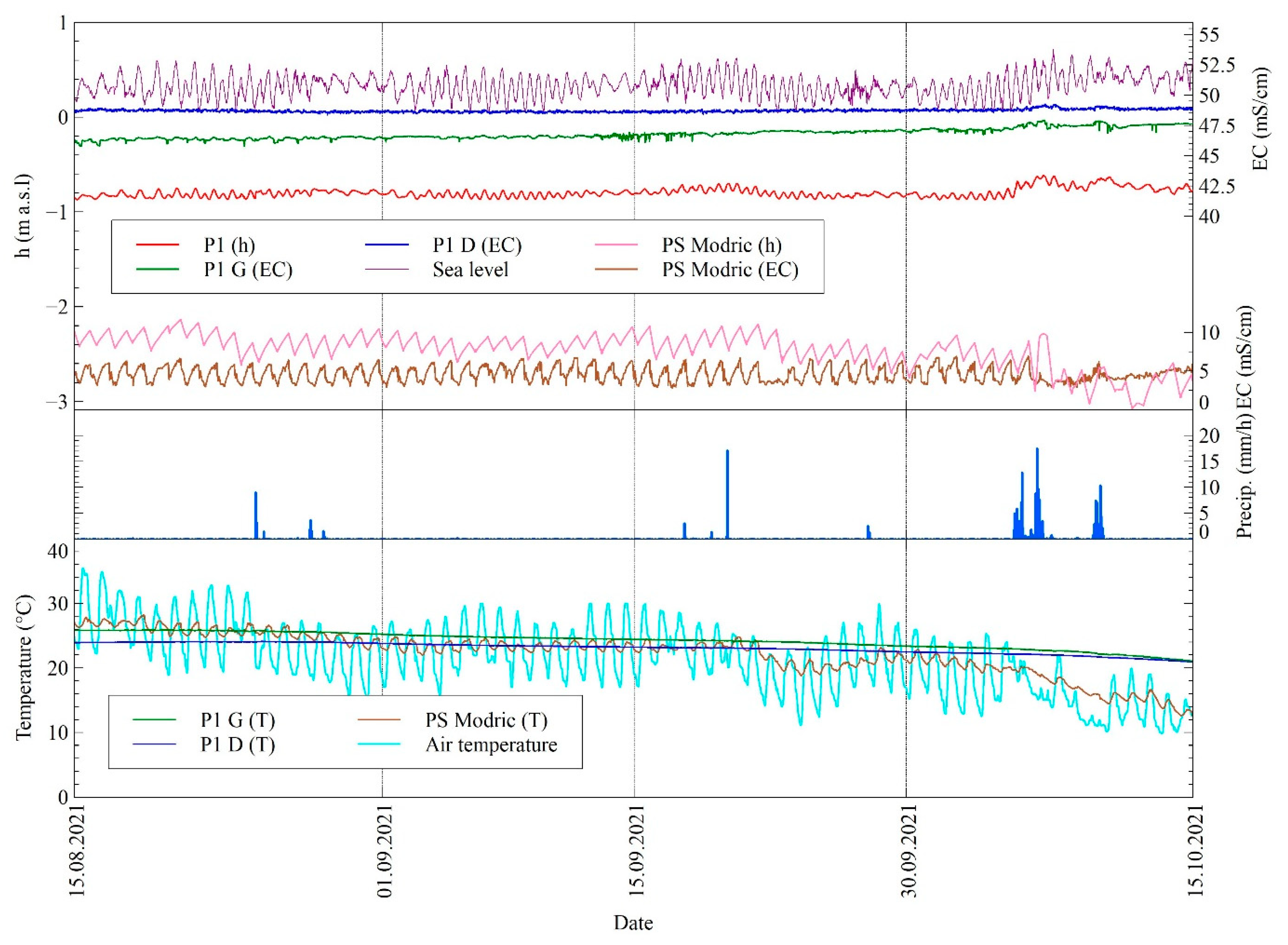
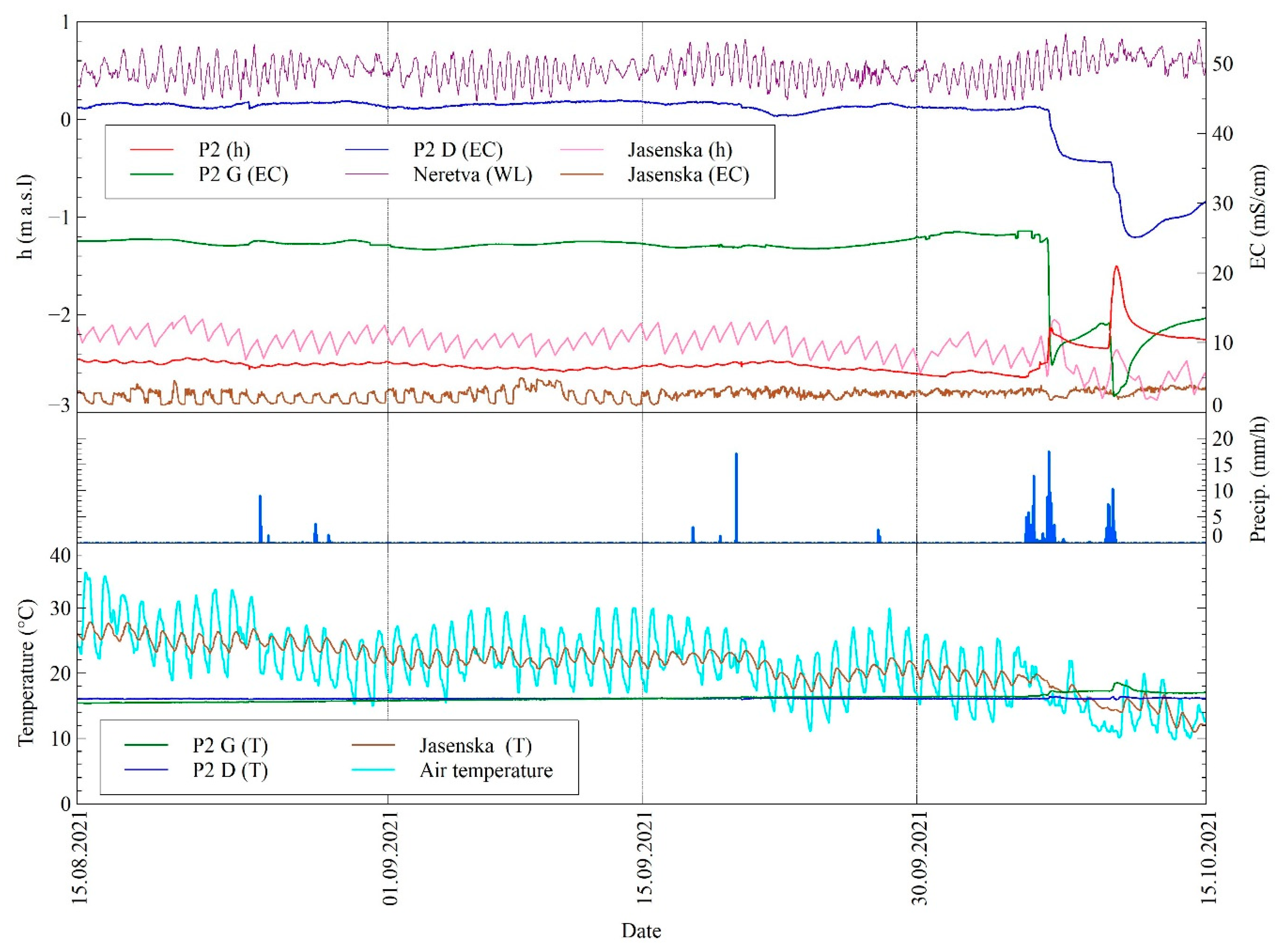
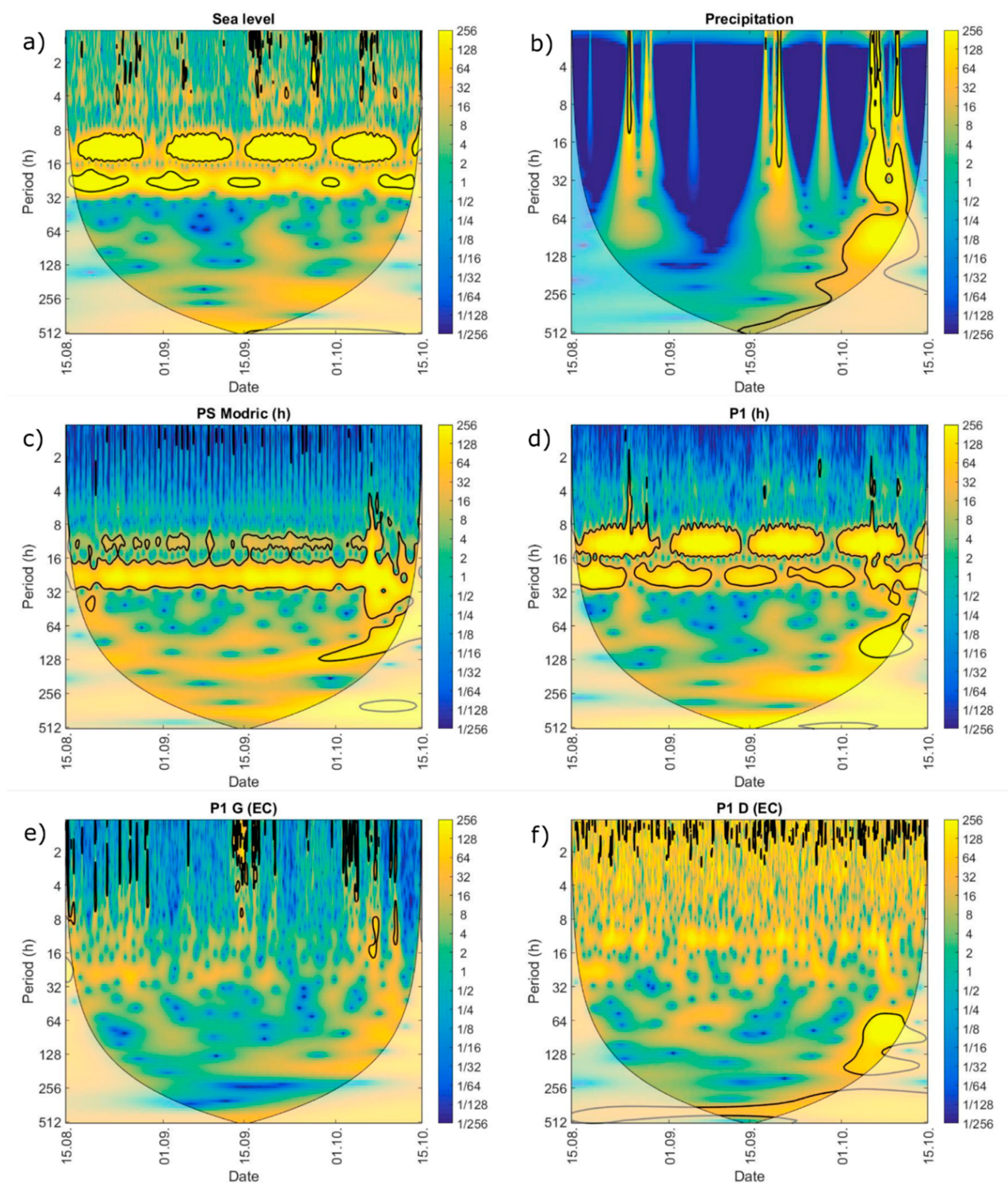


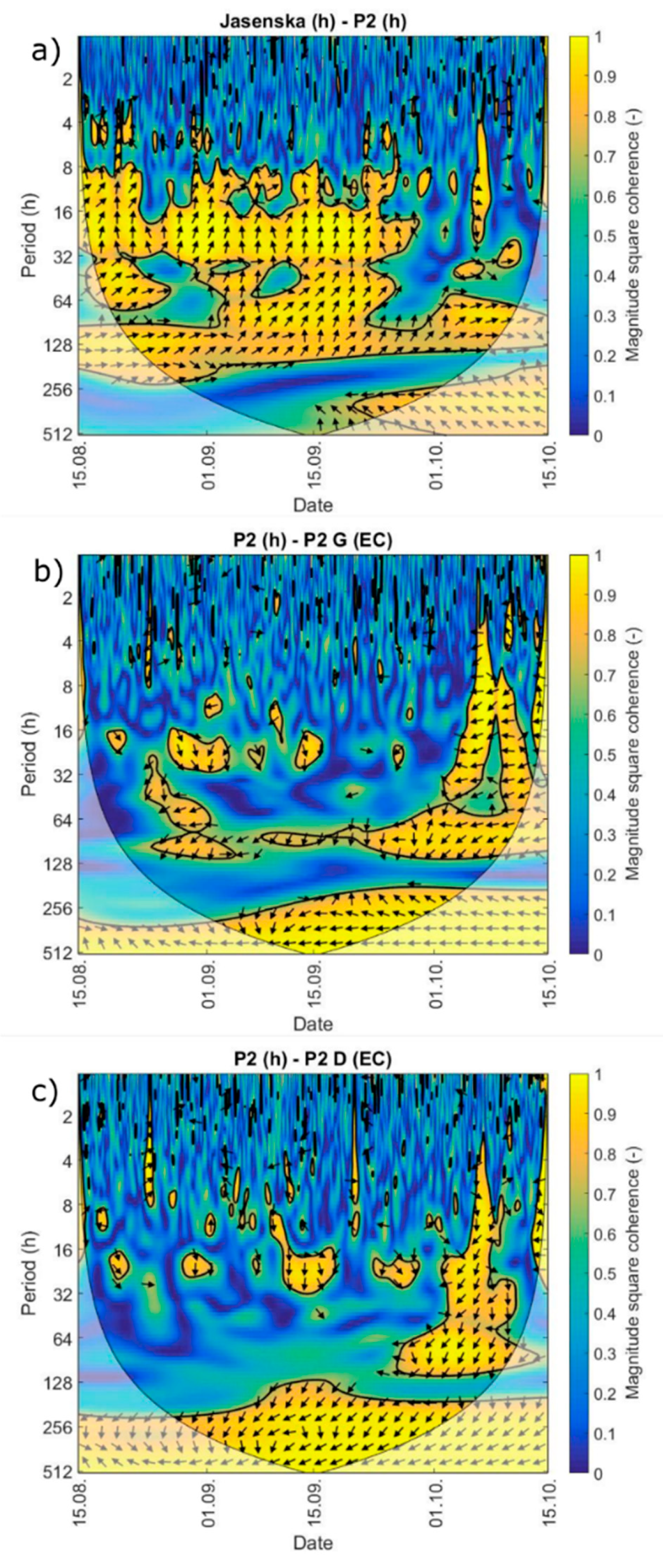
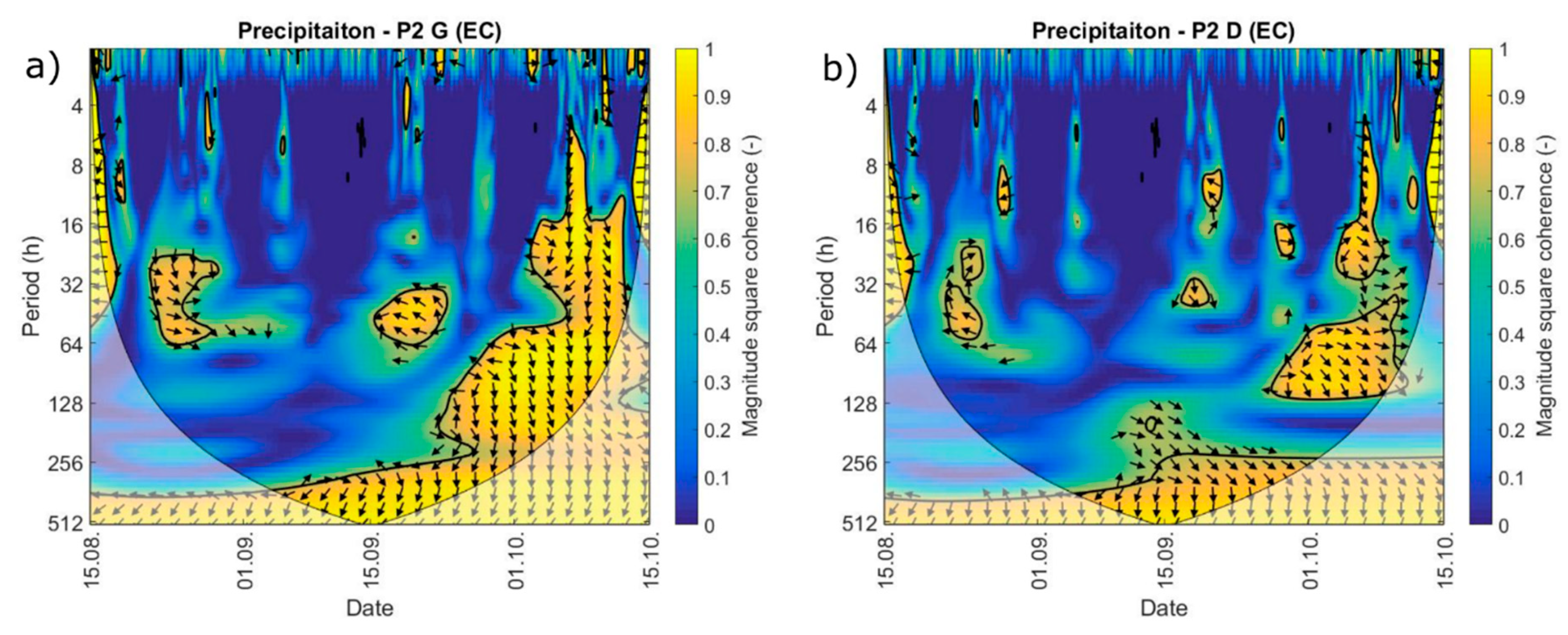
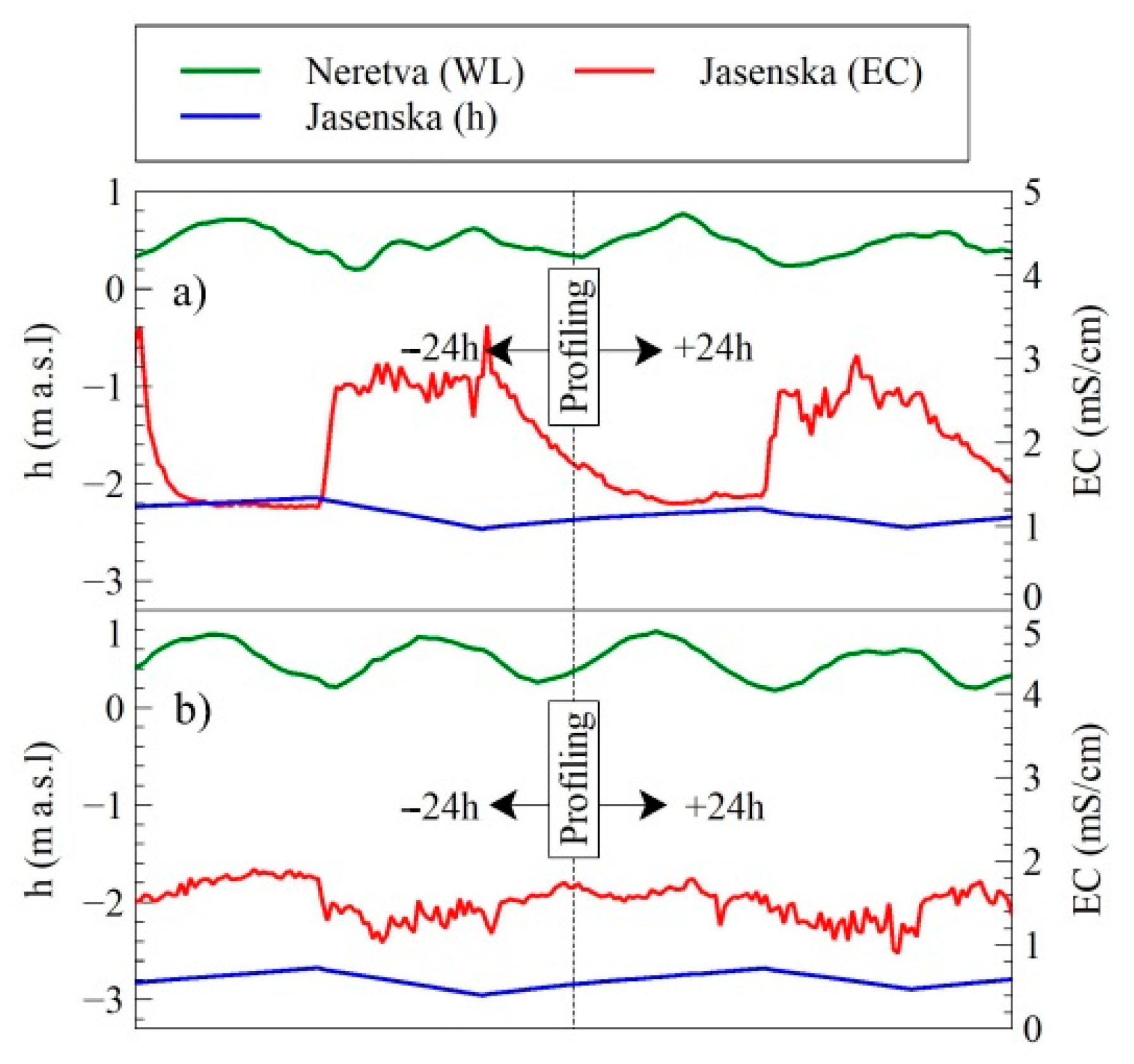

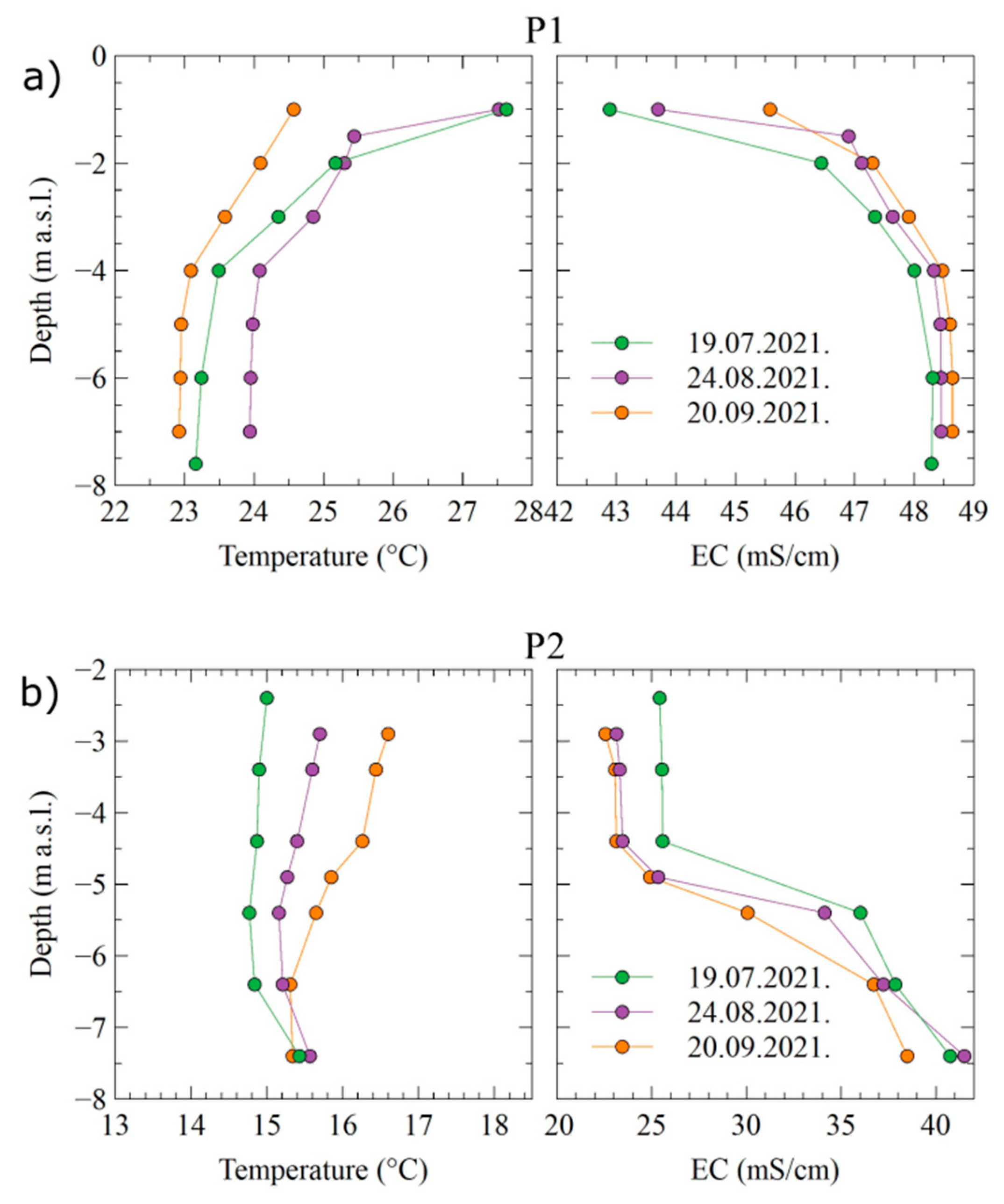

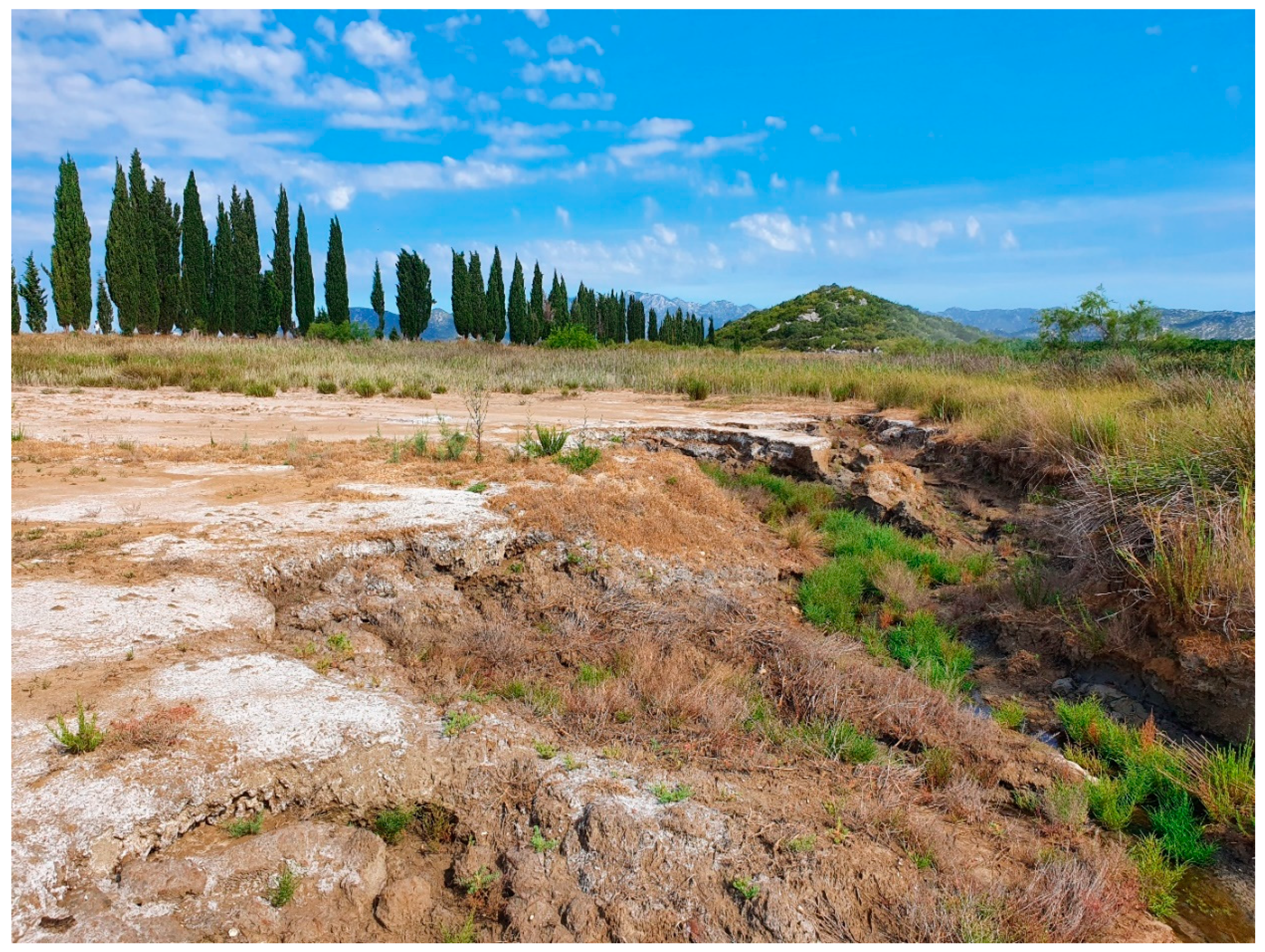
Publisher’s Note: MDPI stays neutral with regard to jurisdictional claims in published maps and institutional affiliations. |
© 2022 by the authors. Licensee MDPI, Basel, Switzerland. This article is an open access article distributed under the terms and conditions of the Creative Commons Attribution (CC BY) license (https://creativecommons.org/licenses/by/4.0/).
Share and Cite
Lovrinović, I.; Srzić, V.; Matić, I.; Brkić, M. Combined Multilevel Monitoring and Wavelet Transform Analysis Approach for the Inspection of Ground and Surface Water Dynamics in Shallow Coastal Aquifer. Water 2022, 14, 656. https://doi.org/10.3390/w14040656
Lovrinović I, Srzić V, Matić I, Brkić M. Combined Multilevel Monitoring and Wavelet Transform Analysis Approach for the Inspection of Ground and Surface Water Dynamics in Shallow Coastal Aquifer. Water. 2022; 14(4):656. https://doi.org/10.3390/w14040656
Chicago/Turabian StyleLovrinović, Ivan, Veljko Srzić, Iva Matić, and Marin Brkić. 2022. "Combined Multilevel Monitoring and Wavelet Transform Analysis Approach for the Inspection of Ground and Surface Water Dynamics in Shallow Coastal Aquifer" Water 14, no. 4: 656. https://doi.org/10.3390/w14040656
APA StyleLovrinović, I., Srzić, V., Matić, I., & Brkić, M. (2022). Combined Multilevel Monitoring and Wavelet Transform Analysis Approach for the Inspection of Ground and Surface Water Dynamics in Shallow Coastal Aquifer. Water, 14(4), 656. https://doi.org/10.3390/w14040656





